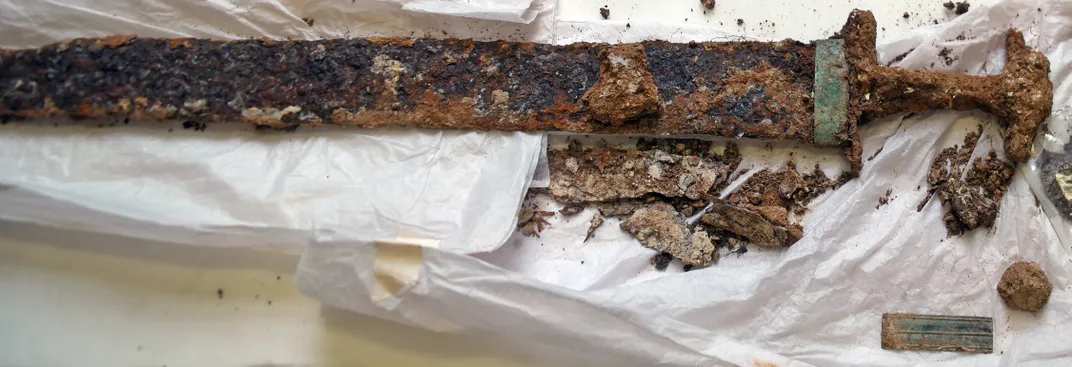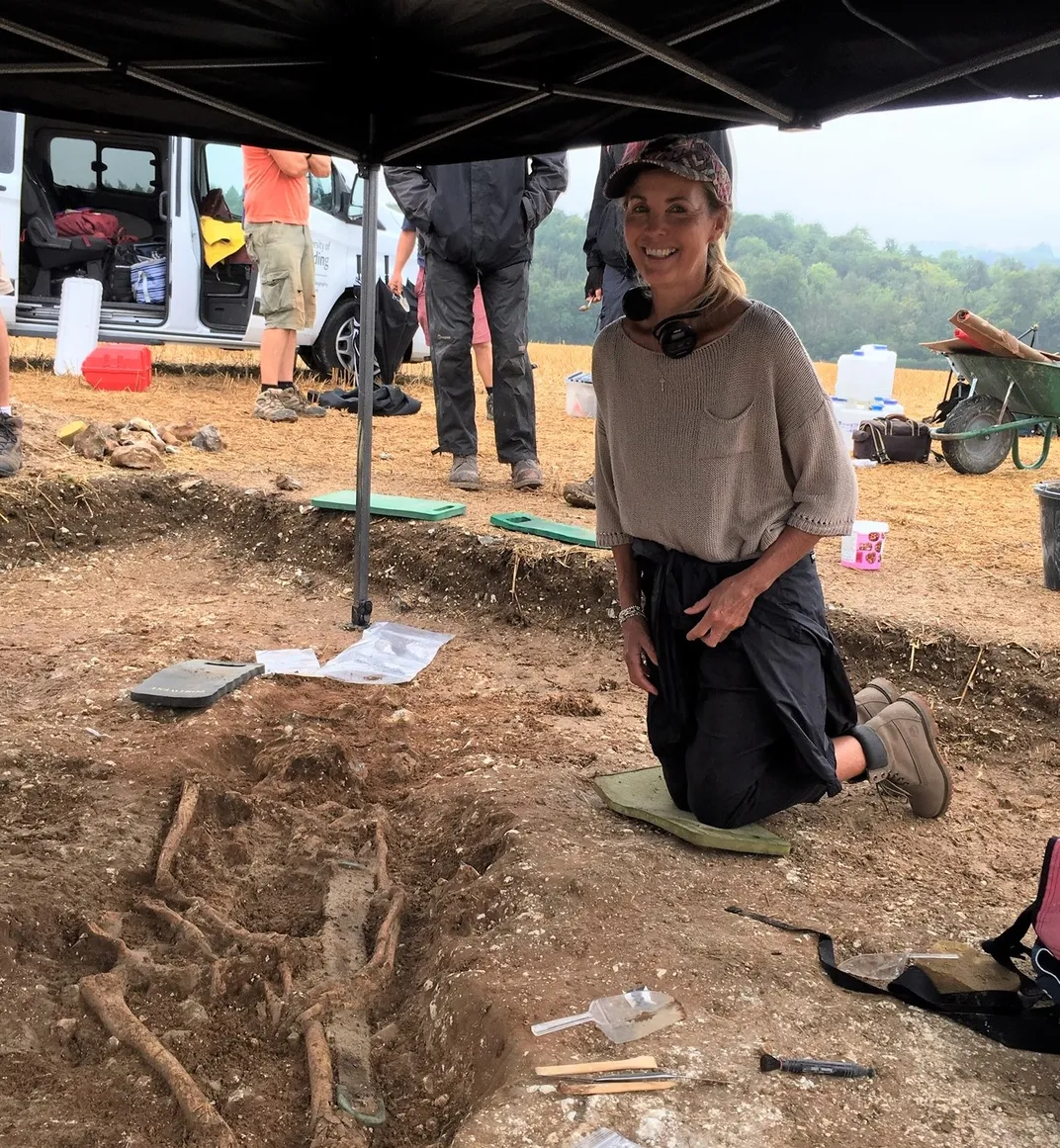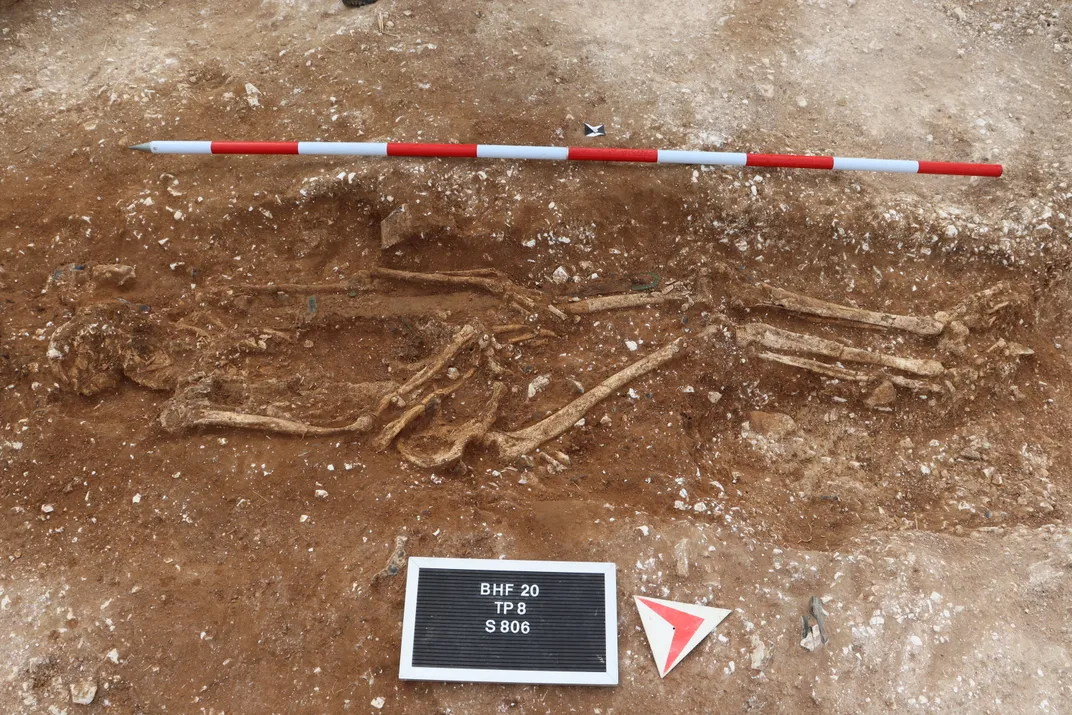Newly Unearthed Warrior’s Grave Poised to Redraw Map of Anglo-Saxon England
Nicknamed the “Marlow Warlord,” the six-foot-tall man was buried on a hill overlooking the Thames sometime in the sixth century A.D.
:focal(2131x1574:2132x1575)/https://tf-cmsv2-smithsonianmag-media.s3.amazonaws.com/filer/e8/4f/e84f0cb8-93d9-420c-bdfa-5b3580795ac6/img_20200813_151658.jpg)
In 2018, amateur metal detectorist Sue Washington was scanning a hilltop overlooking the River Thames when she received a strong signal on her device. Unsure if the signal indicated anything important, she later recalled that “uncertainty preyed on my mind.” Washington and her partner, Mick, returned to the site twice. On their third visit, they happened across a telltale sign of an exciting find: namely, two ancient bronze vessels.
As it turns out, the Washingtons had stumbled onto a 1,400-year-old burial. Realizing the site’s significance, the couple turned the investigation over to the Portable Antiquities Scheme (PAS) for Buckinghamshire, which in turn contacted the University of Reading’s archaeology department.
Archaeologists began digging at the site in earnest this August. Now, the team has revealed what excavations unearthed: a rare Anglo-Saxon grave, complete with a man’s skeleton and an assortment of valuable weapons. Dubbed the “Marlow Warlord” in honor of a nearby town, the “commanding,” six-foot-tall man was buried in a hillside grave sometime in the sixth century A.D.
The find will likely alter historians’ understanding of early British history in the region, according to a statement.
“We had expected to find some kind of Anglo-Saxon burial, but what we found exceeded all our expectations,” says Gabor Thomas, a specialist in early medieval archaeology at the university, in the statement.
He adds, “This the first burial of its kind found in the mid-Thames basin, which is often overlooked in favor of the Upper Thames and London. It suggests that the people living in this region may have been more important than historians previously suspected.”
The number of elaborate, expensive items buried in the grave suggest its occupant was a high-status warrior. As BBC News reports, the man was interred alongside a sword in a decorated scabbard, spears, and bronze and glass vessels.
Unlike most contemporaries, who were laid to rest in cemeteries, the Marlow Warlord was buried alone, in a north-south orientation overlooking the River Thames. In other words, Thomas tells the Guardian’s Nicola Davis, “He is positioned deliberately to look over that territory.”
Analysis of the man’s skeleton indicates that he had well-developed muscles.
“This guy would have been tall and robust compared to other men at the time,” says Thomas in the statement, “and would have been an imposing figure even today.”
The warrior likely lived during a period of immense change. After the Roman occupation of Britain ended in 410 A.D., many tribal Germanic groups migrated to the region, competing to fill a power vacuum left by the empire’s withdrawal.
Historians previously assumed that the mid-Thames basin served as a kind of no-man’s-land or “borderland,” with powerful groups to the north and south.
But as the statement notes, “This new discovery suggests that the area may have hosted important groups of its own.”
Summarizing the finds for the Telegraph, Dominic Penna writes that the evidence indicates “the area was in fact home to its own power base, which was later absorbed by a larger kingdom, and home to a tribe of its own—led by the newly discovered warlord.”
The research team has launched a crowdfunding campaign to support continued excavations at the site. The bronze bowls and spearheads initially discovered by Washington will soon go on display at the Buckinghamshire Museum in Aylesbury, per the statement.
Helena Hamerow, an archaeologist at the University of Oxford who was not involved in the research, describes the find as significant.
“We have few if any burials of that period from the middle Thames region that are so richly furnished, especially in comparison with the lower Thames and upper Thames,” she tells the Guardian. “Both the location and grave goods seem to be designed to project the power and importance of that individual.”
/https://tf-cmsv2-smithsonianmag-media.s3.amazonaws.com/accounts/headshot/nora.png)
/https://tf-cmsv2-smithsonianmag-media.s3.amazonaws.com/filer/a7/00/a700a5ee-cd1e-47f8-a129-ba2b97f756f2/asvessel1afterconservation7.jpg)
/https://tf-cmsv2-smithsonianmag-media.s3.amazonaws.com/filer/b3/94/b394699a-6cfa-43c6-a9a8-280b9238ac0a/img_0193.jpg)
/https://tf-cmsv2-smithsonianmag-media.s3.amazonaws.com/filer/06/e9/06e95865-9542-41b0-9474-c078737e5636/img_1780_credit_james_mather.jpg)
/https://tf-cmsv2-smithsonianmag-media.s3.amazonaws.com/filer/a8/a3/a8a3bdaf-a4df-42ea-add8-50b6cfdc309b/dronestill1.jpg)



/https://tf-cmsv2-smithsonianmag-media.s3.amazonaws.com/accounts/headshot/nora.png)